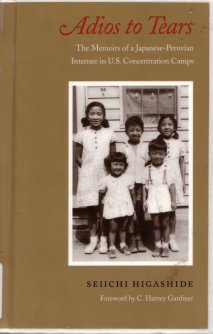
Adios to Tears: The Memoirs of a Japanese-Peruvian Internee in U.S. Concentration Camps

The author was born in Hokkaido and lived in poverty. The book, being memoirs, goes into a lot of details of his early life in Japan. He decided to move to Peru when he grew up, largely because it had the second largest number of Japanese immigrants (second to the U.S.). Life in Peru didn't turn out to be quite as pleasant as he hoped, though, and the book goes on to describe his difficulties getting started in that foreign country.
He describes a revolution in Peru in 1919 and how Japanese shops ended up being looted by mobs. Seiichi, the author, almost got sent back to Japan by the Japanese consulate in Peru for evading the military draft, but the guy changed his mind and let Seiichi remain in Peru.
The book describes his life as he grew older and got better jobs and ended up getting married. He ended up the owner of shop and became president of the Ica Japanese Association, not a position he wanted or campaigned for. By 1939 there were rumors of a Japanese "fifth column" in the country. Some of the rumors and anti-Japanese feeling were due to the U.S. situation with its Issei and Nisei citizens, and some was due to jealousy over the economic success of Japanese immigrants, exactly the same type of thing that was happening in the U.S. in California in relation to farmers.
A major situation erupted over, of all things, the number of barber shops in the area, leading to what was basically a feud. During this a raid on one person's house by the other faction resulted in the death of a Peruvian woman. She was related to the owner of a tabloid newspaper, and that was all it took to start anti-Japanese articles and eventually riots.
After the attack on Pearl Harbor anti-Japanese articles began to appear in newspapers containing lists of "dangerous axis nationals", lists on which Seiichi's name was added. Further, the lists apparently were provided by a U.S. agency. On January 24, 1942, the Peruvian government broke relations with Japan and began to deport some of the Japanese in the country.
The Peruvian government cracked down on Japanese businesses and ordered them to close. The book continues to talk about oppression of the Japanese by the Peruvian government, how some of the Japanese were deported, etc. Once deportations to Japan stopped the people were deported to the U.S. internment camps. Seiichi does, eventually, get arrested and gets sent to a U.S. military camp in Panama.
Eventually he was sent to a small camp in Texas. He goes into how he was reunited with his wife, people who believed that Japan was actually winning the war, the end of the war and how most of his relatives returned to Japan but he chose to stay in the U.S.
He says 2,118 Japanese were deported to the U.S. from 12 countries in Central and South America. 1,024 were actually arrested, the others were family members who voluntarily joined them.
Seiichi and his wife moved to New Jersey where they found out that working for an American food processing company was not as pleasant as it might have seemed it would be, to put it mildly. There's also some interesting comments by the author on differences in American and Japanese cultures as far as how business is done.
Seiichi and his family later moved to Chicago where they had a rough time of things economically. He also talks about Issei and Nisei cultural>
differences.
He and his wife eventually retired to Hawaii. Some of their children later moved there but had problems of their own relating to how Hawaiian-Japanese-Americans perceived mainland-Japanese-Americans. A "kotonk" was a mainlander, and a "Buddhahead" was a Hawaiian Japanese-American. He talks about how this was a problem even during the war for Japanese-American volunteers for the military (and something I saw discussed in a PBS movie about internment.)
The book is quite interesting in its autobiographical approach to being a Japanese immigrant into Peru, only to be forcibly relocated to the U.S. as part of the internment camp program. It's good that he talks about his life after the camps and various problems and successes that he and his wife had. His comments on the culture of U.S. business, the Hawaiian culture and the clash of cultures even within the Japanese-American community are also quite interesting.
Main Index
Japan main page
Japanese-American Internment Camps index page
Japan and World War II index page
|